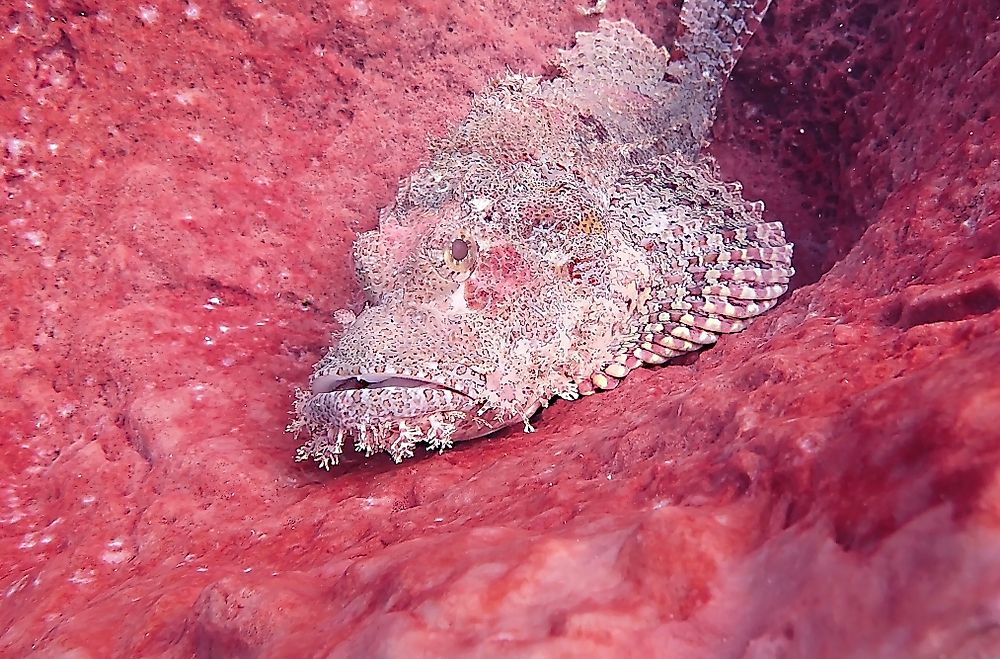
Animals That Live In The Deep Ocean
The deep sea, considered the Earth's largest habitat, reaches an average depth of more than 4000 m. Cold temperatures, darkness, high hydrostatic pressures, low oxygen concentrations, and food scarcity characterize the habitat of the deep sea. Moreover, no light penetrates the ocean waters at depths beyond 1000 m below sea level. Even at depths of 150 m below sea level, the light levels are reduced to 1% of the surface, which makes it insufficient to support photosynthesis. However, despite such extreme conditions, different faunal creatures live in the deep sea and have special adaptations that help them survive in the fathomless depths of the ocean. Much deep-sea fauna is still unknown and is yet to be discovered by scientists. The following article discusses some of these mysterious yet fascinating deep-sea creatures.
- Marine Hatchetfish
- Humpback Anglerfish
- Pelican Eel
- Bloodybelly Comb Jelly
- Lanternfish
- Barreleye Fish
- Zombie Worms
- Giant Isopod
- Deep-Sea Octopus
- Goblin Shark
Marine Hatchetfish
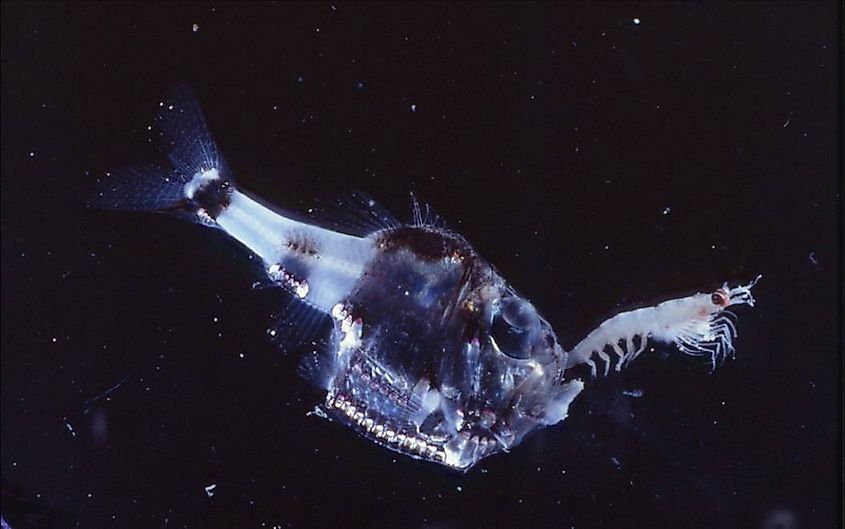
Also referred to as deep-sea hatchet fishes, marine hatchetfishes are small, ray-finned fishes that belong to the subfamily Sternoptychinae. Ranging in size from 2.8 cm to 12 cm, the marine hatchetfishes are found in the tropical, temperate, and subtropical waters of the Atlantic, Indian, and Pacific Oceans. These small, deep-sea creatures have an unusual body shape and possess bioluminescent photophores. These photophores allow the creatures to regulate the brightness of their glow, matching the intensity of light penetrating from above. This counter-illumination eventually helps these creatures escape predators that move in these deep depths. Marine hatchetfishes are found at depths ranging from 50 to 1,500 m.
Humpback Anglerfish
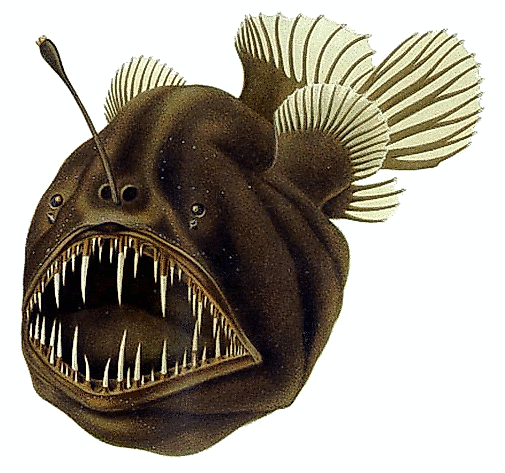
This black-colored soft-bodied anglerfish species is widely found in all tropical and temperate waters. These fishes exhibit extreme sexual dimorphism, with dwarf-sized males and large-sized females. The female humpback anglerfish have large heads, globular bodies, a bulbous luring apparatus on its head, and a widened mouth with long pointed teeth, which help in eating larger prey. The bulbous luring apparatus is used as a bioluminescent mechanism to attract prey. Humpback anglerfish inhabits the mesopelagic and bathypelagic zones of the ocean and is commonly found at depths between 100 to 1,500 m below the water surface. The English naturalist James Yates Johnson discovered the first specimen of humpback anglerfish close to Madeira on December 24, 1863.
Pelican Eel
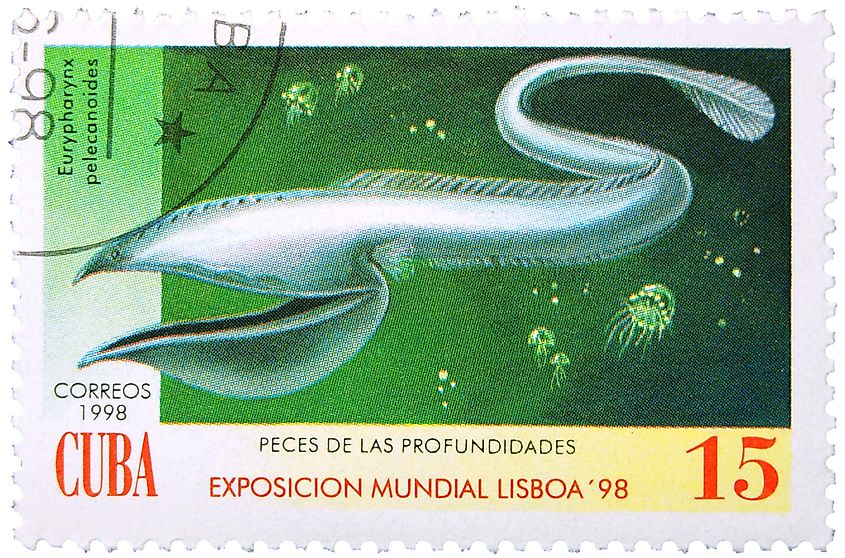
Pelican Eel is one of the most peculiar-looking creatures in the deep sea and is named after its large mouth, which is reminiscent of a pelican. This loosely hinged mouth allows the pelican eel to swallow a fish that is much larger than itself. The eel's mouth can also change to an inflated shape when hunting. However, unlike other eels, the pelican eels lack pelvic fins, scales, and swim bladder. The pelican eel's extremely long, whip-like tail helps in movement and communication via bioluminescence. A complex organ with numerous tentacles at the tail end glows pink in the dark and is used for attracting prey. Pelican eels are found at depths between 500 to 3,000 m.
Bloodybelly Comb Jelly
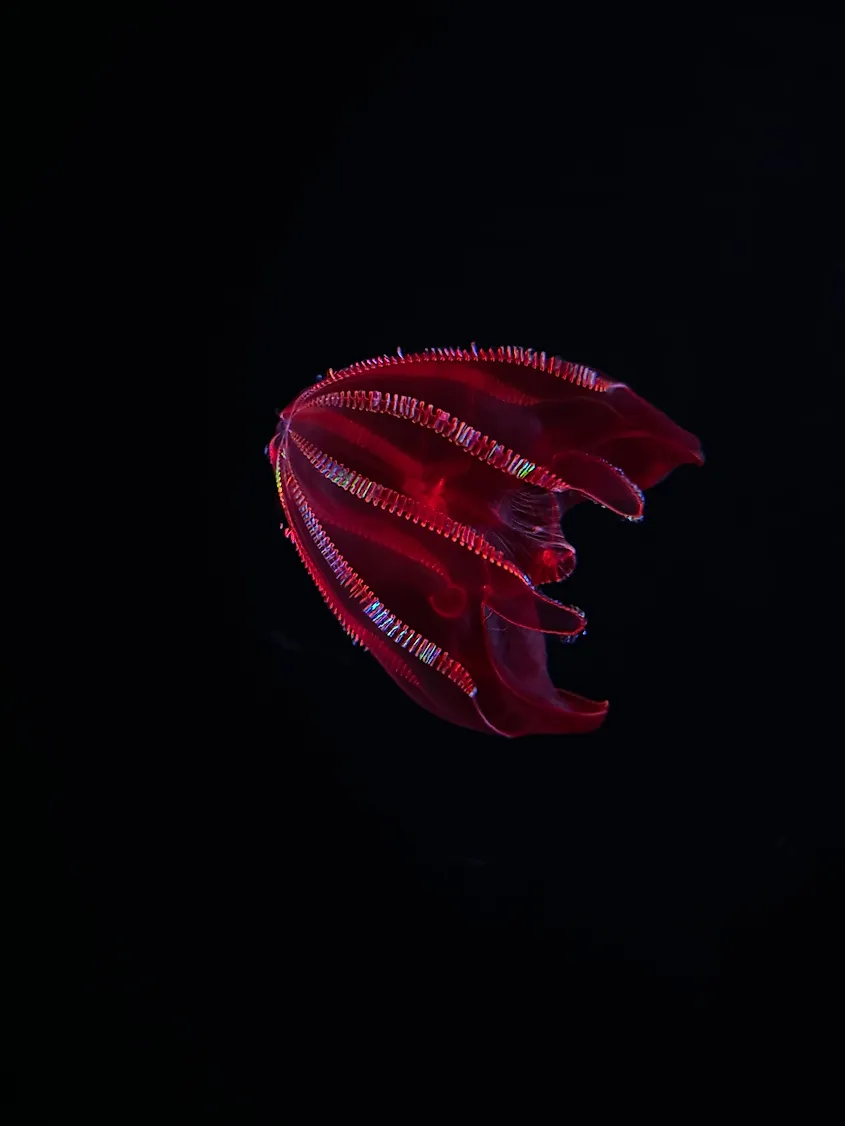
The first specimen of this deep sea creature was collected in 1979 in the Pacific Ocean off the coast of San Diego. The color of this six-inches long mesopelagic ctenophore ranges from deep red to pale purple. The Bloodybelly comb jelly is found at depths between 400 to 1,000 m. In the darkness of the deep sea, the bright red color appears black and blends into the dark background, providing this comb jelly an excellent camouflage hiding it from potential predators. Its blood-red stomach masks the glow of the bioluminescent prey that the animal regularly devours, while the continuous beating of the iridescent hair-like cilia helps to propel these creatures through the waters. Moreover, the bloodybelly comb jelly's sparkling display comes from the light diffracting from these hair-like cilia.
Lanternfish
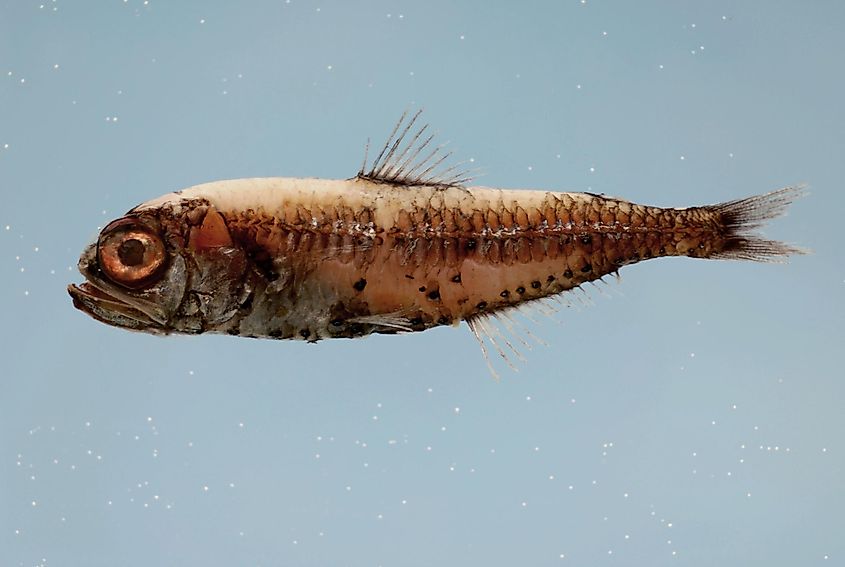
Lanternfishes are the most common and widely distributed deep-sea creatures that comprise over 65% of the deep-sea biomass. This deep-water fish has large eyes, a round head, a large terminal mouth with closely set jaws and rows of tiny teeth, and a thin, compressed body covered with silvery scales and light-producing photophores. Lanternfishes generally range from 2 to 30 cm in length. Lanternfishes are found in all the world's oceans at depths ranging from 360 to 900 m, with the deeper-living species having a dark brown to black color while shallow-living species having iridescent blue to green or silver coloration. These fishes feed on zooplankton and are noted for their diel vertical migrations.
Barreleye Fish
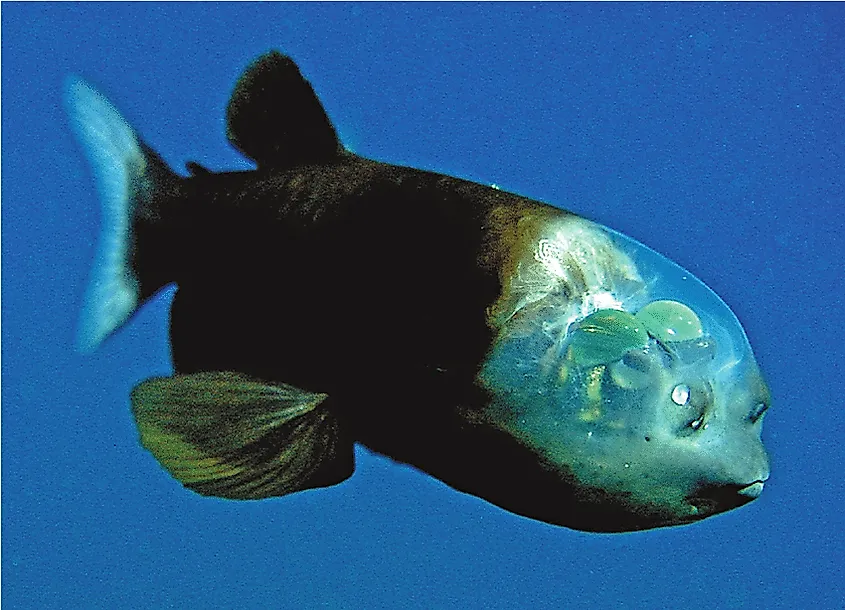
Also referred to as spook fish, Barreleyes are small deep-sea fishes that belong to the family Opisthoproctidae. These fishes are known for their dome-shaped transparent head and two upward-pointing barrel-shaped eyes that help these fishes to detect silhouettes of their prey. The Barreleyes primarily feed on tiny zooplankton like copepods, hydroids, and other aquatic crustaceans. In addition to the barrel-shaped eyes, these fishes have big, flat fins that allow them to maneuver precisely in the water. Barreleye fishes inhabit the mesopelagic to bathypelagic ocean zones at depths ranging from 400 to 2,500 m. The Barreleyes do not undertake diel vertical migrations and remain just beneath the limit of light penetration.
Zombie Worms
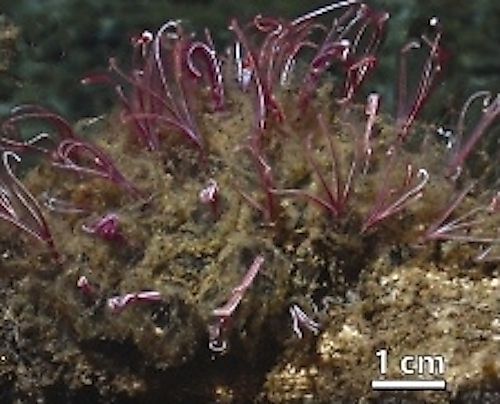
Commonly called zombie worms, Osedax is a group of deep-sea polychaetes known for their unusual feeding habits. These 1 to 3-inch-long Osedax worms bore into the bones of the decaying carcasses of large creatures like whales to feed on the enclosed lipids on which these worms rely for sustenance. The Zombie worms depend on symbiotic bacterial species that help digest whale proteins and lipids and release nutrients that the worms can then absorb. Feathery plumes that spread out from the other end of the worm bodies function as gills and extract oxygen from the seawater. Osedax worms were initially discovered in February 2002, living in the bones of a decomposing gray whale in the Monterey Submarine Canyon at a depth of approximately 2,893 m.
Giant Isopod
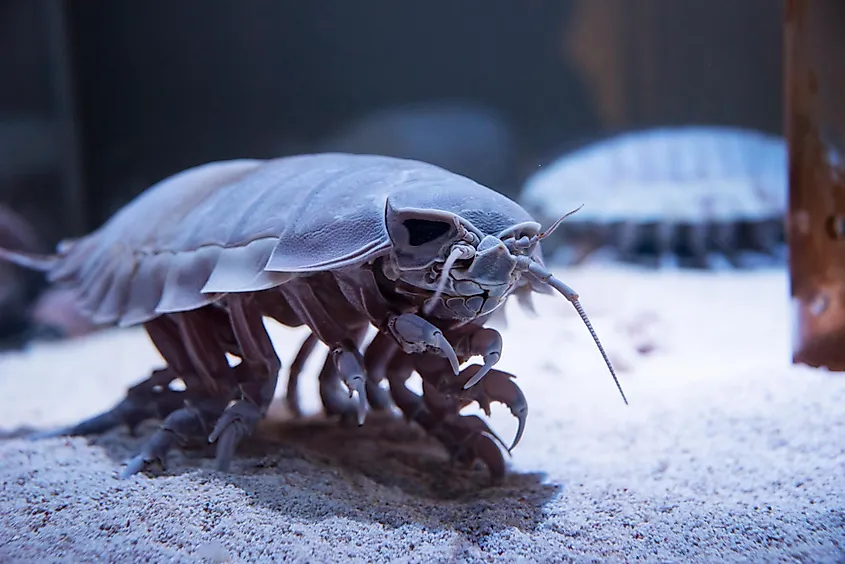
Giant isopods are an excellent example of abyssal gigantism as these creatures are significantly larger than the typical isopods and reach more than 30 cm from head to tail. The bodies of these creatures are dorsoventrally compressed and protected by a calcareous exoskeleton made up of overlapping segments. The giant isopods play the crucial role of scavengers in the deep-sea benthic environment and feed on dead fish, crab bits, marine worms, and occasionally whale carcasses. They are also known to prey on sea cucumbers, nematodes, sponges, and live fish. The giant isopods are mainly found in the gloomy neritic zones of the ocean, at depths ranging between 170 to 2,140 m.
Deep-Sea Octopus
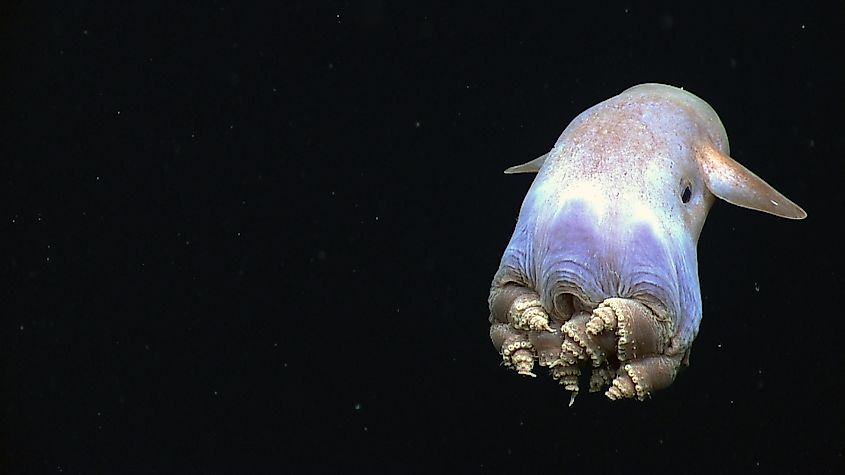
Two octopi, namely the dumbo octopus and the telescope octopus, are found in the deep depths of the ocean. Dumbo Octopus lives at depths of at least 4,000 m or much deeper, making them the deepest living octopuses. Named after Disney's elephant character – Dumbo, the Dumbo octopus uses its ear-like fins to propel through the waters. The dumbo doesn't have an ink sac, as it hardly encounters predators at such great depths. The telescope octopus is the world's only known octopus with tubular eyes. This completely transparent pelagic octopus is found at depths of more than 2000 m in the tropical and subtropical waters of the Pacific and Indian Oceans.
Goblin Shark
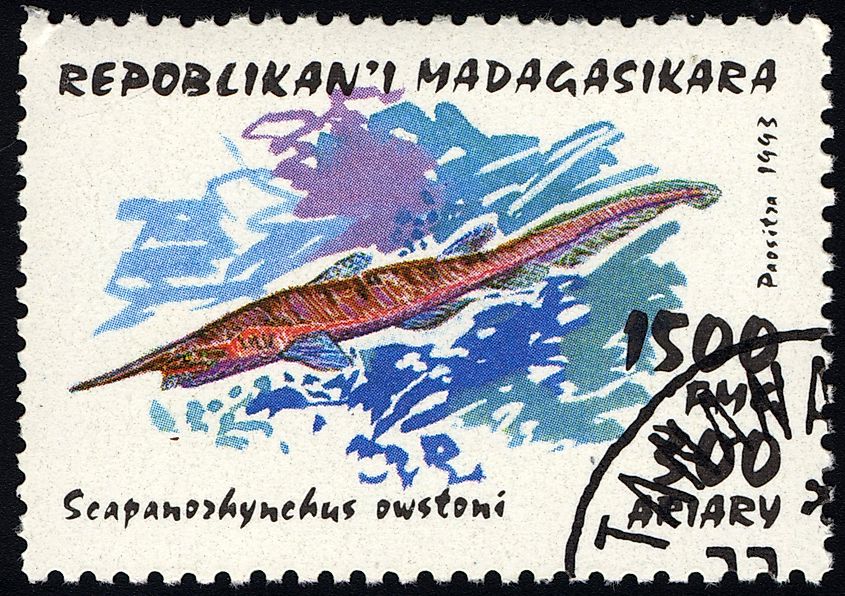
Goblin sharks, resembling mythical goblins of Japanese folklore, are found in deep ocean depths along continental shelves. These pink-skinned sharks have small eyes that lack nictitating membranes and a distinctly long and flat snout. The snout is covered with special sensing organs that help the shark sense electric fields created by other fishes in the low light of their preferred habitat. With highly protrusible jaws and sharp pointed teeth, these sharks mainly feed on teleost fishes besides cephalopods and pelagic crustaceans. Goblin sharks are mostly found on the upper continental slopes at depths of 270 to 960 m but have also often been caught at more profound depths of 1,300 m.
The above article only gives a brief glimpse into the dark world of the deep sea and its fascinating residents. A lot remains to be known about this mysterious world, and scientists believe many deep-sea species are yet to be discovered and documented. Therefore, more studies are required to know about the deep-sea environment, its denizens, and the impacts various anthropogenic activities have on them.











